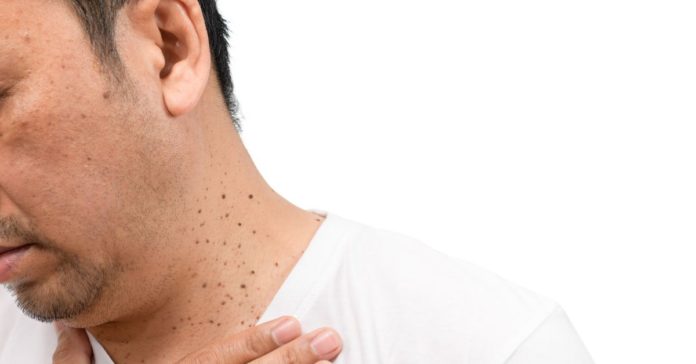Overview
Seborrheic keratosis is a type of non-cancerous skin growth. These usually indicate skin ageing. They appear gradually in variable numbers, commonly on the neck, chest, face, or shoulders. They are easily diagnosed and treated.
What is Seborrheic Keratosis?
Seborrheic keratosis is also known as basal cell papilloma, or seborrheic warts, senile wart, brown wart, wisdom wart, or barnacle. It is a type of harmless skin tumour, which is non-cancerous. These benign lesions usually appear in large numbers on different parts of the body.
The non-contagious disease is prevalent in males and females of all races, usually appearing in middle age, from the 30s or 40s. These small skin warts are common in elders, above the age of 60. They are usually uncommon in adults below the age of 20.
What Causes Seborrheic Keratosis?
The exact cause of the development of the disease is not known.
Scientifically, it appears due to the differentiation and expansion of epidermal skin cells or keratocytes, thus forming these tiny skin outgrowths. Genetic mutation is another probable cause of developing keratosis. They are not associated with potential malignancy.
Viral infection such as the human papillomavirus is unlikely to cause keratosis. However, exposure to sunlight, growing old age, and skin friction are among other potential causes of developing these non-cancerous warts.
What are the Symptoms of Seborrheic Keratosis?
The visual appearance of Seborrheic keratosis looks like moles, warts, barnacles, or skin tumors. They seem stuck onto the skin and appear waxy. These skin warts are usually not painful but sometimes may be associated with skin irritation or itchiness. Lesions are degenerative and tend to increase in number as time passes.
The size of keratosis ranges from tiny to 1 inch across. Four aspects usually describe the physical attributes of seborrheic keratosis:
- Location: The lesions usually are found on the scalp, shoulder, face, chest, abdomen, or back. They are most commonly found on skin folds but never on the soles of the feet or palms.
- Texture: During the initial stages, they appear as small rough bumps. But gradually, they get thicker and tend to develop warty surfaces with a waxy and stuck-on appearance.
- Shape: The shape of lesions varies from round to oval. They look like a flat or raised papule.
- Color: Skin lesions can appear brown, or they can also get pigmented as yellow, black, or white warts.
Depending on the location of the lesions, sometimes they can be very annoying. It is recommended not to scratch the lesions as it may cause bleeding, swelling, or even infection.
What are the Risk Factors Associated with Seborrheic Keratosis?
The risk factor involved in this condition are:
- Age factor: Skin lesions often develop in the elderly population. The risk increases with an increase in age.
- Frequent exposure to sunlight: The UV in the sunlight causes seborrheic keratosis at the exposed parts of the body, such as the neck. Nevertheless, they also appear on parts of the body that are usually not exposed to sunlight.
- Genetic: The condition seems to run in families. Hence, genetic mutations may also cause the development of seborrheic keratosis.
What are the Complications of Seborrheic Keratosis?
Sometimes Seborrheic keratosis is often mistaken as a skin tumour or melanoma. Very rarely, the development of eruptive seborrheic keratosis may indicate internal malignancy. Sometimes, this unusual occurrence was considered a sign of internal cancer. Doctors call it “the sign of Leser Trélat”. The correlation is not yet explained or proven and may only be a coincidence.
Adverse reactions to medication or chemotherapy may also cause lesions to arise. Sometimes inflamed and crustated seborrheic keratosis may also end up giving rise to eczematous dermatitis.
Or
How is Seborrheic Keratosis diagnosed?
Keratosis can be diagnosed merely by physical appearance . It can also be distinguished easily from other skin conditions by performing a skin biopsy followed by a dermoscopy.
When to See a Doctor?
Seborrheic Keratosis is usually not lethal. However, one must consult a doctor in suspicious cases such as the development of new growth, unusual texture or color of growth, change in the appearance of growth, or growth associated with pain. It is always better to be cautious.
What are the available treatments for Seborrheic Keratosis?
Seborrheic Keratosis usually doesn’t require any treatment unless it causes physical or emotional discomfort. They are painless, but a doctor can successfully remove them in case of any suspicious appearance.
Methods of removal are:
- Cryosurgery: Freezing the growth using liquid nitrogen
- Electro-surgery: Application of electrical current to scrape off the growth
- Curettage: Use a scoop-like surgical instrument, usually electro-surgery, to remove the skin outgrowths.
- Focal chemical peel with the help of trichloroacetic acid.
- Ablative laser surgery.
Conclusion
Seborrheic Keratosis is a harmless, non-cancerous warty spot or lesion, which usually appears as a sign of skin ageing. The condition can be treated if necessary. However, the lesions tend to persist or may recur spontaneously from time to time.
Frequently Asked Questions (FAQs)
Q.1. Why do people often confuse Seborrheic Keratosis with skin melanoma?
ANS. Seborrheic keratosis appears as moles or waxy warts in nature. On the other hand, skin melanoma often takes up the same shape and texture as harmless skin lesions or warts. However, proper diagnosis by a doctor can differentiate between the two. Skin melanoma is a skin cancer and needs treatment at the earliest .
Q.2. How can Seborrheic Keratosis be prevented?
ANS. There is no known way to prevent it. The condition seems associated with skin ageing and genetics.
Q.3. Are there any side effects associated with the removal of Seborrheic Keratosis?
ANS. It is not easy to remove all the multiple lesions at once. Also, loss of skin pigment at the site of surgery is one of the major concerns. In most cases, the regrowth of lesions does not occur at the same spot but may appear at different parts of the body.


















